
Carta Marina Medieval Sea Monster Map of Scandinavia: Tile Backsplash
Medieval Medieval Tiles Bestiary Arts & Crafts Pre-Raphaelite Victorian

Medieval Medieval Tiles Bestiary Arts & Crafts Pre-Raphaelite Victorian
Welcome Catalog How to Order Tile Site Map Contact Search Articles

Carta Marina backsplash, 48 inches x 36 inches.
Thirty-six 8x6 inch tiles

The Carta Marina was drawn by Olaus Magnus on 9 woodblocks. Consequently, the sections do not stitch together perfectly. This works well for tile with its complementary grout lines.
Olaus Magnus Gothus greets the honorable reader. To be able to understand easily this map of the Scandinavian countries and the wonders that exist there.... you must know that it is divided into nine parts, indicated by the large letters A, B, C. etc.

Application: These tiles are suitable for interior use and can be installed on walls, backsplashes, showers and any interior application. They won't stand up to outdoor freezes and thaws.
Title: Carta Marina of Olaus Magnus, Sea Monster Map
Sizes: 24 x 18 inches, and 48 x 36 inches
Tile: Ceramic
Availability: The 24-inch version can ship in about 3 weeks. The 48-inch version takes a bit longer, 3 to 4 weeks.

24 x 18 inch (nine 8 x 6 inch tiles): $1700
24 x 18 inch (nine 8 x 6 inch tiles) with 10 accent tiles: $196048 x 36 inch (thirty-six 8 x 6 tiles): $4670
48 x 36 inch (thirty-six 8 x 6 tiles) with 10 accent tiles: $5010

You may want accent tiles to intersperse with your field tile.
Title: Carta Marina Accent tilesSizes: 4.25 inch, 6 inch
Without mural (4.25 inch, 6 inch): $55, $83



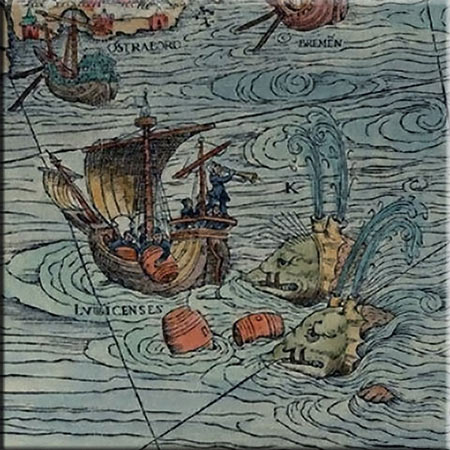

From top left: Sea Unicorn and ships; Island whale; Polar bears surfing ice flow; Pristers; Bonfires of Chaos


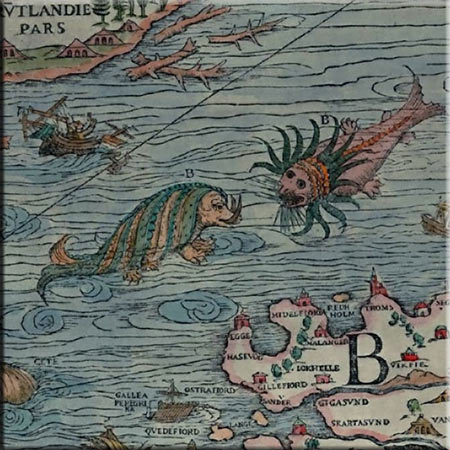



From top left: Old Man of the Sea; Great Orm and Maelstrom; Rosmarus confronting The Kraken; Loki sweeping; Climbing Rosmarus and Dragon; Prancing reindeer




From top left: Archers; giant fish and net; polar bear hunting; sunworshippers and giant bird, X marks the spot




From top left: Sea swine, Balena, Orca, and mythical island of Thule; Giant Polypus capturing a sailor; Ziphius (owl whale) devouring a seal while being attacked by a spined orca; sea unicorn, flying fish, phister, and sea swine with ship



From top left: Sea rhino, Vermis worm, Sea cow




From top left: Reindeer ice sleds; coiled serpents and duck tree; an icebound ship encircled by predators; pelican and albatross

Northern bonfires of the British Isles, sea ducks and monster.
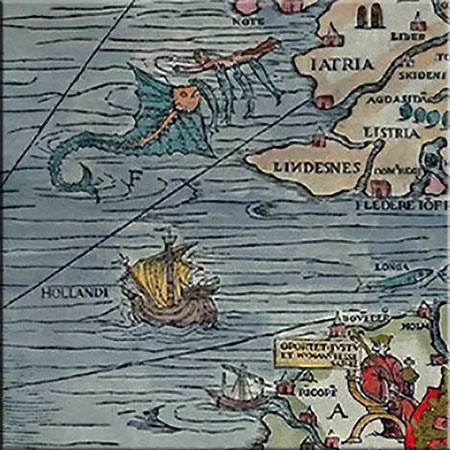
Rockas protecting a man from dog fish chewing his tender parts

Livonia: Bear climbing a tree and knocking down a behive, horse and rider impaled by a bull, shipyard

The Carta Marina is a navigation map, intended for sailors. As a Swede, Olaus Magnus knew the map of Scandinavia in the 1482 edition of Claudius Ptolemy's Geographia was hopelessly inaccurate. To set the record straight and to provide the best possible aid to navigators, he made the Carta Marina
Olaus Magnus worked on the Carta Marina (A Marine map and Description of the Northern Lands and of their Marvels, most carefully drawn up at Venice in the year 1539 through the generous assistance of the Most Honourable Lord and Patriarch Hieronymo Quirino) diligently between 1527 and 1539 while he was on a diplomatic trip in Rome. Olaus overstayed his visit to Rome by 12 years because he could not return to Sweden, his brother Johannes, the last Catholic archbishop in Sweden, having had a falling out with King Gustav I. When Johannes died in 1544, Pope Paul III made Olaus his successor as Archbishop of Upsalla. But by then, Sweden was no longer a Catholic country, so Olaus was Archbishop of Nothing.
Olaus also wrote Historia de Gentilbus Septentrionalibus (History of the Northern Peoples), a book of folkstore and history and was translated into Intalian, German, English and Dutch in the next 100 years or so. It was finally translated into Swedish in 1909.
The intrigue: The map disappeared in 1574 and for the next few centuries it was rumored that such a map had never existed. It was rediscovered in 1886 in Munich, and then another copy was found in Switzerland in 1961.


Horror Vacui: On Cartographers' Fear of Blank Spaces (Stanford Libraries)
Why Ancient Mapmakers Were Terrified of Blank Spaces (National Geographic)
Ocean Eddies in the 1539 Carta Marina by Olaus Magnus (Plymouth Marine Library, PDF)

Vermis, sea snake. There is on the Coasts of Norway, a Worm of a blew and gray color, that is above 40 Cubits long, yet is hardly so thick as the arm of a child. He goes forward in the Sea like a Line, that he can hardly be perceived how he goes; he hurts no man, unless he be crushed in a mans hand: for by the touch of his most tender Skin, the fingers of one that toucheth him will swell.

Ducks being hatched from the fruit of the trees. There is a strange multitude of great Ducks, which they call Sollendae, which live on Fish; and these are not the same with wild or tame Ducks... but because they are like them in color and form, they are called Ducks; but for difference sake Sollend Ducks. These Ducks come yarly by flocks in the Spring, from the South, to the Rock Bassense. At the end of Autumn, they fly three days about the Rock, and then they fly by Troops to the South parts, to live all the winter.

Sea Cow. The Sea-Cow is a huge Monster, strong, angry, and injurious; she brings forth a young one like to her self; yet not above two, but one often, which she loves very much.... this Creature is known to have lived 130 years, by cutting off her Tail.

Carbiddas vortex (Maelstrom). ...the Mariners that come thither unawares, are in a moment sucked in by its sudden circumvolution, all force and industry of the Pilot being taken away, especially those who know not the Nature of the place, or at otherwise driven on by the force of Tempests; of that, by contempt, little regard this imminent danger. This is the Charybdis vortex, known to Aristotle, and referred to in the less common saying, 'Between Scylla and Charybdis'.

Ziphius (Xiphias). Owl Whale eating a seal, while being attacked by a spined fish. He hath an ugly head as an Owl His mouth is wondrous deep, as a vast pit, whereby he tarries and drives away those that look into it. His Eyes are horrible, his Back Wedge-fashion, or elevated like a sword; his Snout is pointed. These often enter upon the Northern Coasts, as Thieves, and hurtful Guests, that are always doing mischief to ships they meet, but boaring holes in them and sinking them....

Sea Unicorn. The Unicorn is a Sea-Beast, having on his Fore-head a very great Horn, wherewith he can penetrate and destroy the ships in his way, and drown multitudes of men. But divine goodnesse hath provided for the safety of Marriners herein; for though he be a very fierce Creature, yet is he very slow, that such as fear his coming may fly from him.

Polypus. On the Coasts of Norway, there is Polypus, one Creature with many feet, which hath a pipe on his back, whereby he puts to see, and he moves that sometimes to the right side, sometimes to the left. Moreover, with his Legs as it were by hollow places, dispersed here and there, and by his Noothed Nippers, he fastneth on every living Creature that comes near to him, that wants blood.... He changeth his color by the color of the stone he sticks unto, especially when he is frightened at the sight of his enemy the Conger.... He lies on his back upon the stones, that he can scare be gotten off of, unless you put some stinking smell to him.

Sea rhino. A monster looking like a rhinocerous devours a lobster which is 12 feet long.

Old man in the sea. Monsters in the Sea almost like to men, that sing mournfully as the Sea Nymphs. Also Sea-men, that have a full likeness of body, and thse in the night will seem to go up into the ships; and it is proved, that when they appear there is some danger coming; and if they stay long the ships are drowned.

The Kraken. Their Forms are horrible, their Heads square, all set with prickles, and they have sharp and long Horns round about, like a tree rooted up by the Roots. They are ten or twelve Cubits long, very black, and with huge eyes. The compass whereof is above eight or ten cubits. The Apple of the Eye is of one Cubit, and is red and fiery coloured, which in the dark of night appears to Fisher-men afar off under Waters, as a burning fire, having hairs like Goose-Feathers, thick and long, like a Beard hanging down. The rest of the body, for the great of the head, which square, is very small, not being above 14 or 15 Cubits long; one of these Sea-Monsters will drown easily many great ships provided with many strong Marriners.

Island Whale. The Whale hath upon his Skin a Superficies, like the gravel that is by the Sea-Side, so that oft-times, when he raiseth his back above the waters, Saylors take it to be nothing else but an Island and sayl unto it, and go down upon it, and they strike in piles unto it, and fasten them to their ships; they kindle fires to boyle their meat; until at length the Whale feeling the fire, dives down to the bottome....

Rosmarus. They are reported a kind of Whales, who shew their cruelty at first sight, and make men afraid to see them; and if men look long on them, they will fright and amaze them. If this monster is indeed a Rosmarus (Olaus does not call it by name):
The Norway Coast, toward the more Northern parts, had huge great fish as big as Elephants, which are called Morsi, or Rosmari, may be that they are so from their sharp biting, for if they see any man on the Sea-shore, and can catch him, they come suddenly upon him and rend him with their Teeth, that they will kill him in a trice... They will raise themselves with their Teeth, as by Ladders, to the very tops of Rocks, that they may feed on the Dewie Grasse, or fresh Water, and role themselves in it, and then go to the Sea again.

Balena and Orcha. A Whale is a very great fish about one hundred or three hundred foot long, and the body isa vast magnitude; yet the Orca, which is smaller in quantity, has more nimble to assaunt, and cruel to come on, is his deadly Enemy. An Orca is like a hull turned inside outward; a Beast with fierce Teeth, with which, as with the Stern of a Ship, he rends the Whales Guts, and tears his Calves body, or he quickly runs and drives him up and down with his prickly back...
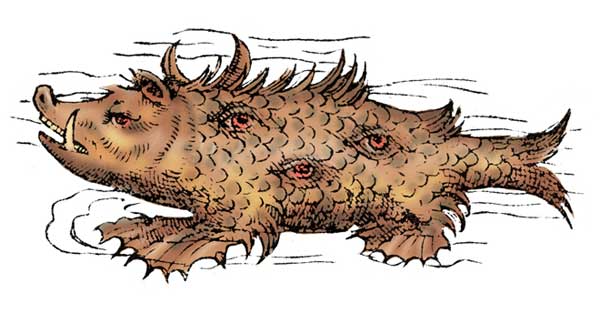
Sea Swine. A monstrous Fish found on the shores of England, with a clear description of his whole body, and every member thereof,... was seen there in the the year 1532, and the Inhabitants made a prey of it.... For it had a Hogs head, and a quarter of a circle, like the moon, in the hinder part of its head, four feet like a Dragon, two eyes on both side of his Loyns, and a third in his belly inkling toward his Navel; behind he had a Forked-Tail, like to other Fish commonly."

Rockas and dog fish. There is a fish of the kind of Sea-Dog-fish... in Norway, Haafisck, that will set upon a man swimming in the Salt-Waters, so greedily, in Troops, unawares, that he will sink a man to the bottom, no only by his biting but also by his weight; and he will eat his more tender parts as the Nostrils, Fingers, Privities, until such time as the Ray come to revenge these injuries, which runs thorow the Waters armed with her natural fins and with some vioence drives away those fish that set uponed the drown'd man, and doth what he can to urge him to swim out.

Pristers. The Whirlpool, or Prister, is of the kind of Whales, two hundred Cubits long, and is very cruel... The Beast hath... a long and large round mouth, like a Lamprey, whereby he sucks in his meat or water, and by his weight cast upon the Fore or Hinder-Deck, he sinks and drowns a ship.
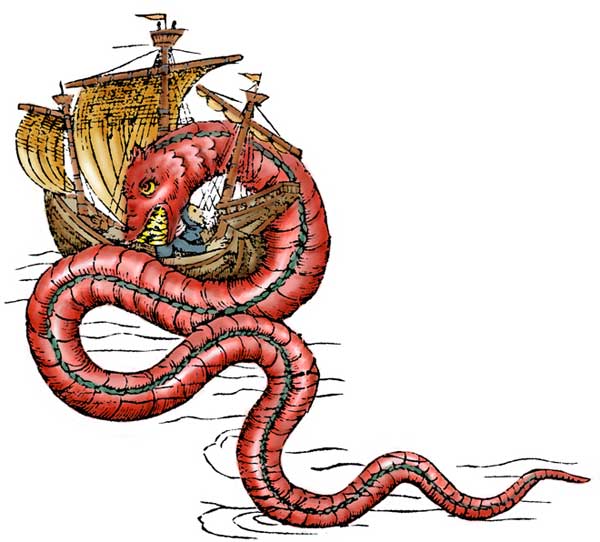
Great Orm. On the Coasts of Norway... there is a Serpent there which is of a vast magnitude, namely 200 foot long, and more-- over 20 feet thick; and it is wont to live and Rocks and Caves toward the Sea-coast about Berge; which will go along from his holes in a clear night in Summer and devour calves, Lambs, and Hogs, or else he goes into the Sea to feed on Polypus, Locusts, and all sorts of Sea-Crabs.... This Snake puts up his head on high like a pillar, and catcheth away men, and he devours them; and this hapneth not but it signifies some wonderful change of the Kingdom near at hand, namely that the Princes shall die, or be banished, or some Tumultuous Wars shall promptly follow.
The Carta Marina was drawn by Olaus Magnus on 9 woodblocks. It's original size (stiched together) is 67 inches by 47 inches. The woodblocks:
